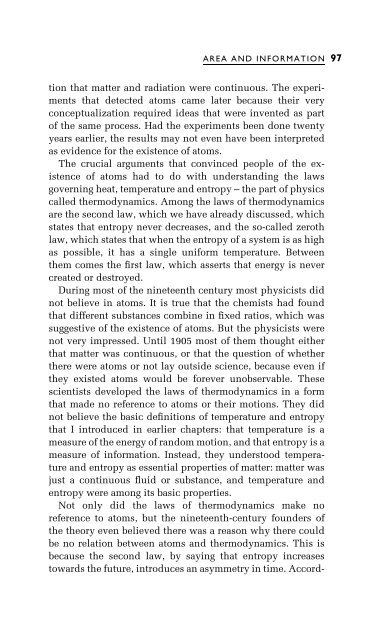Three Roads To Quantum Gravity
Three Roads To Quantum Gravity
Three Roads To Quantum Gravity
Create successful ePaper yourself
Turn your PDF publications into a flip-book with our unique Google optimized e-Paper software.
AREA AND INFORMATION<br />
97<br />
tion that matter and radiation were continuous. The experiments<br />
that detected atoms came later because their very<br />
conceptualization required ideas that were invented as part<br />
of the same process. Had the experiments been done twenty<br />
years earlier, the results may not even have been interpreted<br />
as evidence for the existence of atoms.<br />
The crucial arguments that convinced people of the existence<br />
of atoms had to do with understanding the laws<br />
governing heat, temperature and entropy ± the part of physics<br />
called thermodynamics. Among the laws of thermodynamics<br />
are the second law, which we have already discussed, which<br />
states that entropy never decreases, and the so-called zeroth<br />
law, which states that when the entropy of a system is as high<br />
as possible, it has a single uniform temperature. Between<br />
them comes the ®rst law, which asserts that energy is never<br />
created or destroyed.<br />
During most of the nineteenth century most physicists did<br />
not believe in atoms. It is true that the chemists had found<br />
that different substances combine in ®xed ratios, which was<br />
suggestive of the existence of atoms. But the physicists were<br />
not very impressed. Until 1905 most of them thought either<br />
that matter was continuous, or that the question of whether<br />
there were atoms or not lay outside science, because even if<br />
they existed atoms would be forever unobservable. These<br />
scientists developed the laws of thermodynamics in a form<br />
that made no reference to atoms or their motions. They did<br />
not believe the basic de®nitions of temperature and entropy<br />
that I introduced in earlier chapters: that temperature is a<br />
measure of the energy of random motion, and that entropy is a<br />
measure of information. Instead, they understood temperature<br />
and entropy as essential properties of matter: matter was<br />
just a continuous ¯uid or substance, and temperature and<br />
entropy were among its basic properties.<br />
Not only did the laws of thermodynamics make no<br />
reference to atoms, but the nineteenth-century founders of<br />
the theory even believed there was a reason why there could<br />
be no relation between atoms and thermodynamics. This is<br />
because the second law, by saying that entropy increases<br />
towards the future, introduces an asymmetry in time. Accord-



![arXiv:1001.0993v1 [hep-ph] 6 Jan 2010](https://img.yumpu.com/51282177/1/190x245/arxiv10010993v1-hep-ph-6-jan-2010.jpg?quality=85)


![arXiv:1008.3907v2 [astro-ph.CO] 1 Nov 2011](https://img.yumpu.com/48909562/1/190x245/arxiv10083907v2-astro-phco-1-nov-2011.jpg?quality=85)








![arXiv:1002.4928v1 [gr-qc] 26 Feb 2010](https://img.yumpu.com/41209516/1/190x245/arxiv10024928v1-gr-qc-26-feb-2010.jpg?quality=85)
![arXiv:1206.2653v1 [astro-ph.CO] 12 Jun 2012](https://img.yumpu.com/39510078/1/190x245/arxiv12062653v1-astro-phco-12-jun-2012.jpg?quality=85)
